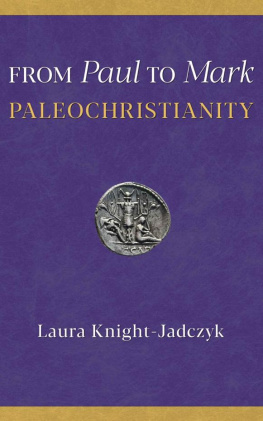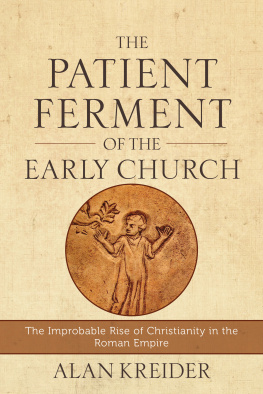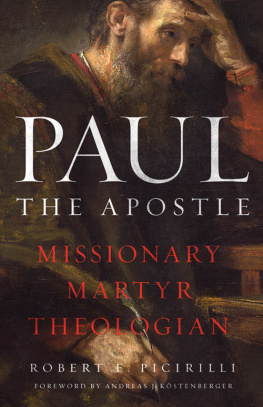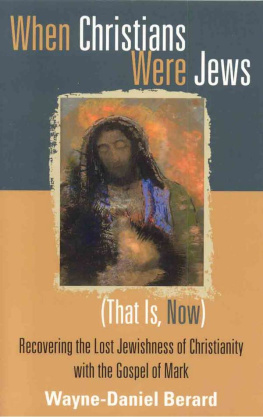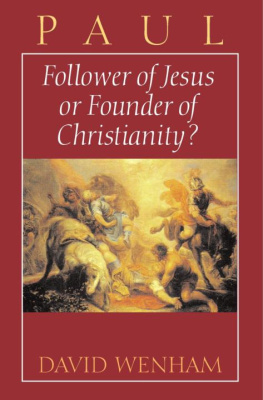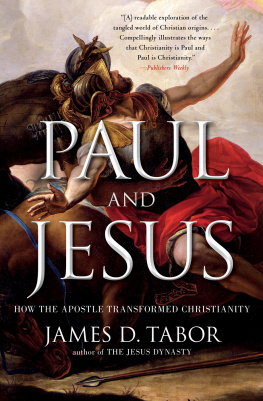FROM Paul TO Mark
PALEOCHRISTIANITY
Red Pill Press
2021
Copyright 2021 Laura Knight-Jadczyk
Cover image: Denarius of Julius Caesar; Spanish mint, 46 45 BCE. Reverse: Gallic military trophy with a captured Gaul on one side and a mourning female symbolizing Gallia, defeated, on the other. Berlin, Altes Museum. Credits: Barbara McManus, 2012.
Published by Red Pill Press (www.redpillpress.com)
295 Scratch Branch Rd.
Otto, NC 28763
USA
First edition.
No part of this publication may be reproduced, stored in a retrieval system, or transmitted in any form or by any means, electronic, mechanical, or otherwise, other than for fair use, without the written consent of the author.
Contents
To my husband. This is my UFT, now it is your turn.
Acknowledgements
Juliana Barembuem, Niall Bradley, Lucien Koch, Harrison Koehli, Joseph Quinn, all of whom made thisunwieldy text better, especially Harrison my Bible Buddy and the main editor of this text. Hiscontributions have been invaluable even when we sometimes disagree. Sergey Kopeyko brought theefforts of all the rest of us together in book form.
I owe a huge debt to many biblical scholars whose brilliance and insight made it possible for me topiece together the picture that emerged from studying their works. I must also acknowledge quite a fewclassical scholars whose historical analyses have acted on me in such a way as to benefit mymethodology. I believe I have acknowledged all individually throughout the text and in footnotes. Iapologize if I missed anyone. I will not apologize for lengthy quotes; sometimes, the words of theoriginal author simply cannot be improved upon and any attempts to do so only mangle themessage.
Special gratitude to Richard Pervo, Philip R. Davies, Russell Gmirkin, and Robert M. Price forreading the text and offering many helpful suggestions.
Foreword
This book began as a close study of the history of the time during which Christianity arose. I wasfocused on searching for any clue that anybody anywhere during that time might have known oralluded to a historical Jesus of Nazareth, even obliquely. Yes, others have done this before me, and Isurely stand on the shoulders of giants of biblical research, but I think I have been able tobring some fresh views to the table. Like many researchers, such as Michael Goulder and Fr.Thomas Brodie, I have just followed the texts where they lead and have been forced torealize that many ideas whether old or new, consensus or fringe had to be discardedwhen a major flaw in the argument was exposed by a cold, hard fact. The process has takenmost of my adult life more intensely in the last dozen years or so. And though I am stillan amateur by the standards of the trained Old Testament, New Testament and Classicalscholars, I have relied on so many of them for ideas and data that I would only hope oneor two might take the time to read what I have assembled from their much appreciatedlabors.
This book covers many topics, some of which may seem tangential to its main subject. Doing theresearch, it became obvious that only by looking at the problem from different angles might sufficientlight be shone on the solution so as to make it clear. The state of the evidence is far from ideal, andrequires a wide net. Two thousand years of what amounts to a cover-up isnt easily cleared away toreveal the few barest facts that have managed to slip through the net of deception. But in the end, Ithink I have elucidated some things about the times, the actors, and the events. Its not perfect, andIm sure there may be things Ive missed; Ive noted several unanswered questions here and there inthe text, as well as problems that would be better dealt with by an expert in one or anotherfield.
During the years I was working on this book, I had the great privilege to correspond with a numberof brilliant scholars, several of whom stand out as having been extraordinarily kind and helpful to me,an amateur. Two of them died while I was still laboring and the loss was devastating to me. This was soeven though I did not know them personally other than by correspondence, and because I was verymuch attached to their way of thinking and working, their books and articles; knowing that there wouldbe no more from either of them left me feeling utterly bereft. Professors Philip R. Davies(19452018) In the end, it is simply a matter of historical reconstruction and what is most likely tohave happened based on the usual historical methodology, setting aside all confessionalbeliefs.
However, confessional beliefs are not the only dogmas that can block ones vision of the past. Anytheory that is taken as a priori truth, whether consciously acknowledged or not, can seriously limit ourunderstanding of history, so we must strive towards as true an understanding of the worldwe live in as possible. This then will allow us to practice what English philosopher R. G.Collingwood called re-enacting history putting ourselves in the shoes of historical actors, so tospeak. For this to work, we need both sides of the equation: meticulous historical research and as muchknowledge about the workings of our world and our role in it as possible. So, to give you a betterunderstanding of where Im coming from, let me give you some background on how I view our presentcondition and how in many ways, it echoes the conflicts that were going on at the time of the ApostlePaul and early Christianity, and how this might help us make sense of the historical data wehave.
First let me note that several of the authors I quote in this book are Christian. Others, includingmany of the Jesus mythicists, are secular atheists. I agree with the atheists that the Christianscholars religious beliefs hamper their objectivity. But when it comes to the atheists, I think they arefundamentally wrong about the nature of reality, and this hampers their own work in other ways. Socount yourself warned. Im not a member of either camp and some of my remarks below andthroughout the text are sure to offend not just the fundamentalists, but the atheists too. Butrest assured: these views do not have a bearing on my actual historical conclusions. Thesensitive reader is free to skip over such sections and continue on where the historical argumentresumes.
As many of my readers know, my husband is a mathematical physicist and an expert in hyperdimensionalphysics. He has spent his life in pursuit of GUFT Grand Unified Field Theory the Holy Grail of physics,while I have pursued a similar goal in history and religion. In a sense, this book is my religio-historicalUFT. As such, it doesnt just contain my historical arguments and conclusions. It is informed by myown worldview, and contains some of my thoughts about the nature of reality and how humanityinterfaces with that reality: religion.
Religion is a cultural sign language which promises a gain in life by corresponding to anultimate reality. So writes Gerd Theissen in his book A Theory of Primitive Christian Religion .
The definition leaves open whether and in what sense there is an ultimate reality. In religion, a gain in life is often to be understood in a very tangible way, above all as health and help But often religions promise something more sublime in addition: a life in truth and love, a gain of identity in the crises and changes of life even the promise of eternal life.
He expands on this by explaining:
Cognitively, religions have always offered a comprehensive interpretation of the world: they assign human beings their place in the universe of things Religion maintains belief in a hidden order of things and it functions where our knowledge fails in cognitive crises (for example in the question of what lies beyond this world in which we live and what removes us from ourselves at death).

